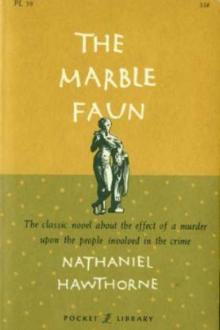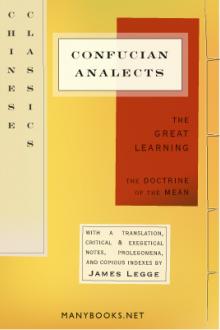The Marble Faun, vol 1, Nathaniel Hawthorne [top 100 books to read txt] 📗

- Author: Nathaniel Hawthorne
- Performer: -
Book online «The Marble Faun, vol 1, Nathaniel Hawthorne [top 100 books to read txt] 📗». Author Nathaniel Hawthorne
But the idea was unjust to the sex at large, and especially so to this poor Miriam, who was hardly responsible for her frantic efforts to be gay. Possibly, moreover, the nice action of the mind is set ajar by any violent shock, as of great misfortune or great crime, so that the finer perceptions may be blurred thenceforth, and the effect be traceable in all the minutest conduct of life.
“Did you see anything of the dear child after you left us?” asked Miriam, still keeping Hilda as her topic of conversation. “I missed her sadly on my way homeward; for nothing insures me such delightful and innocent dreams (I have experienced it twenty times) as a talk late in the evening with Hilda.”
“So I should imagine,” said the sculptor gravely; “but it is an advantage that I have little or no opportunity of enjoying. I know not what became of Hilda after my parting from you. She was not especially my companion in any part of our walk. The last I saw of her she was hastening back to rejoin you in the courtyard of the Palazzo Caffarelli.”
“Impossible!” cried Miriam, starting.
“Then did you not see her again?” inquired Kenyon, in some alarm.
“Not there,” answered Miriam quietly; “indeed, I followed pretty closely on the heels of the rest of the party. But do not be alarmed on Hilda’s account; the Virgin is bound to watch over the good child, for the sake of the piety with which she keeps the lamp alight at her shrine. And besides, I have always felt that Hilda is just as safe in these evil streets of Rome as her white doves when they fly downwards from the tower top, and run to and fro among the horses’ feet. There is certainly a providence on purpose for Hilda, if for no other human creature.”
“I religiously believe it,” rejoined the sculptor; “and yet my mind would be the easier, if I knew that she had returned safely to her tower.”
“Then make yourself quite easy,” answered Miriam. “I saw her (and it is the last sweet sight that I remember) leaning from her window midway between earth and sky!”
Kenyon now looked at Donatello.
“You seem out of spirits, my dear friend,” he observed. “This languid Roman atmosphere is not the airy wine that you were accustomed to breathe at home. I have not forgotten your hospitable invitation to meet you this summer at your castle among the Apennines. It is my fixed purpose to come, I assure you. We shall both be the better for some deep draughts of the mountain breezes.”
“It may he,” said Donatello, with unwonted sombreness; “the old house seemed joyous when I was a child. But as I remember it now it was a grim place, too.”
The sculptor looked more attentively at the young man, and was surprised and alarmed to observe how entirely the fine, fresh glow of animal spirits had departed out of his face. Hitherto, moreover, even while he was standing perfectly still, there had been a kind of possible gambol indicated in his aspect. It was quite gone now. All his youthful gayety, and with it his simplicity of manner, was eclipsed, if not utterly extinct.
“You are surely ill, my dear fellow,” exclaimed Kenyon.
“Am I? Perhaps so,” said Donatello indifferently; “I never have been ill, and know not what it may be.”
“Do not make the poor lad fancy-sink,” whispered Miriam, pulling the sculptor’s sleeve. “He is of a nature to lie down and die at once, if he finds himself drawing such melancholy breaths as we ordinary people are enforced to burden our lungs withal. But we must get him away from this old, dreamy and dreary Rome, where nobody but himself ever thought of being gay. Its influences are too heavy to sustain the life of such a creature.”
The above conversation had passed chiefly on the steps of the Cappuccini; and, having said so much, Miriam lifted the leathern curtain that hangs before all church-doors in italy. “Hilda has forgotten her appointment,” she observed, “or else her maiden slumbers are very sound this morning. We will wait for her no longer.”
They entered the nave. The interior of the church was of moderate compass, but of good architecture, with a vaulted roof over the nave, and a row of dusky chapels on either side of it instead of the customary side-aisles. Each chapel had its saintly shrine, hung round with offerings; its picture above the altar, although closely veiled, if by any painter of renown; and its hallowed tapers, burning continually, to set alight the devotion of the worshippers. The pavement of the nave was chiefly of marble, and looked old and broken, and was shabbily patched here and there with tiles of brick; it was inlaid, moreover, with tombstones of the mediaeval taste, on which were quaintly sculptured borders, figures, and portraits in bas-relief, and Latin epitaphs, now grown illegible by the tread of footsteps over them. The church appertains to a convent of Capuchin monks; and, as usually happens when a reverend brotherhood have such an edifice in charge, the floor seemed never to have been scrubbed or swept, and had as little the aspect of sanctity as a kennel; whereas, in all churches of nunneries, the maiden sisterhood invariably show the purity of their own hearts by the virgin cleanliness and visible consecration of the walls and pavement.
As our friends entered the church, their eyes rested at once on a remarkable object in the centre of the nave. It was either the actual body, or, as might rather have been supposed at first glance, the cunningly wrought waxen face and suitably draped figure of a dead monk. This image of wax or clay-cold reality, whichever it might be, lay on a slightly elevated bier, with three tall candles burning on each side, another tall candle at the head, and another at the foot. There was music, too; in harmony with so funereal a spectacle. From beneath the pavement of the church came the deep, lugubrious strain of a De Profundis, which sounded like an utterance of the tomb itself; so dismally did it rumble through the burial vaults, and ooze up among the flat gravestones and sad epitaphs, filling the church as with a gloomy mist.
“I must look more closely at that dead monk before we leave the church,” remarked the sculptor. “In the study of my art, I have gained many a hint from the dead which the living could never have given me.”
“I can well imagine it,” answered Miriam. “One clay image is readily copied from another. But let us first see Guido’s picture. The light is favorable now.”
Accordingly, they turned into the first chapel on the right hand, as you enter the nave; and there they beheld,—not the picture, indeed,—but a closely drawn curtain. The churchmen of Italy make no scruple of sacrificing the very purpose for which a work of sacred art has been created; that of opening the way; for religious sentiment through the quick medium of sight, by bringing angels, saints, and martyrs down visibly upon earth; of sacrificing this high purpose, and, for aught they know, the welfare of many souls along with it, to the hope of a paltry fee. Every work by an artist of celebrity is hidden behind a veil, and seldom revealed, except to Protestants, who scorn it as an object of devotion, and value it only for its artistic merit.
The sacristan was quickly found, however, and lost no time in disclosing the youthful Archangel, setting his divine foot on the head of his fallen adversary. It was an image of that greatest of future events, which we hope for so ardently, at least, while we are young,—but find so very long in coming, the triumph of goodness over the evil principle.
“Where can Hilda be?” exclaimed Kenyon. “It is not her custom ever to fail in an engagement; and the present one was made entirely on her account. Except herself, you know, we were all agreed in our recollection of the picture.”
“But we were wrong, and Hilda right, as you perceive,” said Miriam, directing his attention to the point on which their dispute of the night before had arisen. “It is not easy to detect her astray as regards any picture on which those clear, soft eyes of hers have ever rested.”
“And she has studied and admired few pictures so much as this,” observed the sculptor. “No wonder; for there is hardly another so beautiful in the world. What an expression of heavenly severity in the Archangel’s face! There is a degree of pain, trouble, and disgust at being brought in contact with sin, even for the purpose of quelling and punishing it; and yet a celestial tranquillity pervades his whole being.”
“I have never been able,” said Miriam, “to admire this picture nearly so much as Hilda does, in its moral and intellectual aspect. If it cost her more trouble to be good, if her soul were less white and pure, she would be a more competent critic of this picture, and would estimate it not half so high. I see its defects today more clearly than ever before.”
“What are some of them?” asked Kenyon.
“That Archangel, now,” Miriam continued; “how fair he looks, with his unruffled wings, with his unhacked sword, and clad in his bright armor, and that exquisitely fitting sky-blue tunic, cut in the latest Paradisiacal mode! What a dainty air of the first celestial society! With what half-scornful delicacy he sets his prettily sandalled foot on the head of his prostrate foe! But, is it thus that virtue looks the moment after its death struggle with evil? No, no; I could have told Guido better. A full third of the Archangel’s feathers should have been torn from his wings; the rest all ruffled, till they looked like Satan’s own! His sword should be streaming with blood, and perhaps broken halfway to the hilt; his armor crushed, his robes rent, his breast gory; a bleeding gash on his brow, cutting right across the stern scowl of battle! He should press his foot hard down upon the old serpent, as if his very soul depended upon it, feeling him squirm mightily, and doubting whether the fight were half over yet, and how the victory might turn! And, with all this fierceness, this grimness, this unutterable horror, there should still be something high, tender, and holy in Michael’s eyes, and around his mouth. But the battle never was such a child’s play as Guido’s dapper Archangel seems to have found it.”
“For Heaven’s sake, Miriam,” cried Kenyon, astonished at the wild energy of her talk; “paint the picture of man’s struggle against sin according to your own idea! I think it will be a masterpiece.”
“The picture would have its share of truth, I assure you,” she answered; “but I am sadly afraid the victory would fail on the wrong side. Just fancy a smoke-blackened, fiery-eyed demon bestriding that nice young angel, clutching his white throat with one of his hinder claws; and giving a triumphant whisk of his scaly tail, with a poisonous dart at the end of it! That





Comments (0)